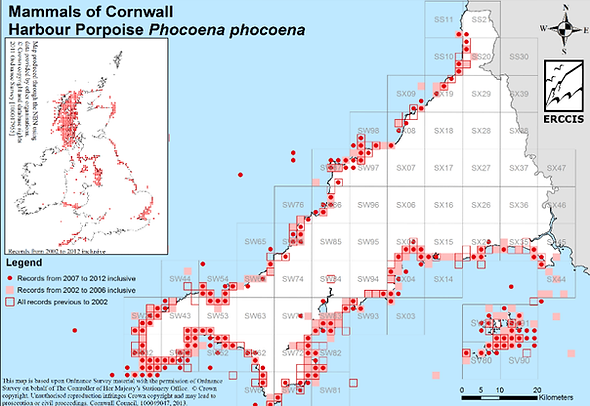
Harbour porpoise-(Phocoena phocoena)
Order: Cetacea, Cornish Name: Morhogh
Recognition:

Harbour porpoises from the south-west are significantly longer (at up to 1.9 m) than those from other areas around the UK, suggesting that they may be a separate stock. Cornish fishermen used to call the harbour porpoise the ‘sniffer’.
The smallest cetacean seen in UK waters and the only member of the porpoise family living around our coasts, the harbour porpoise is a rotund animal up to 1.5 m long with a small blunt
head and no obvious beak. There is a small triangular fin half way along the dark grey back. The colour fades to a pale belly. At sea only the rounded back and fin are seen and the animal rarely leaps clear of the water. In stranded animals it may be possible to see the large numbers (38-56) of spade- shaped teeth in each jaw, as compared to the pointed teeth of the dolphins. The subtle external differences between male and female mean that it is rarely possible to distinguish between the sexes in live sightings. Harbour porpoises are often solitary
or seen in small groups of up to a dozen individuals, but occasionally larger pods of several hundred animals are sighted. The larger groups seem to be associated with long-distance movements or feeding concentrations and occur
mainly in early spring or late autumn.
The harbour porpoise is found from the subtropical to subarctic zones of the Northern hemisphere, mainly over the continental shelf at depths of 20-100 m. It is often seen around coasts and within estuaries and is the most commonly recorded of our cetaceans. Research indicates a population of about 350,000 animals around the UK. Relatively little is known about the harbour porpoise but there are occasional peaks in sightings and strandings which may be related to changes in their prey
species. It is thought that some groups maintain home ranges and there seem to be at least two separate populations around the UK.
They feed on fish, squid and crustaceans taken both mid-water and from the sea floor. Harbour porpoises can swim at speeds of up to 22 km/hr, although they are usually much slower. They can dive for up to 15 minutes at a time and have been recorded reaching depths of 226 m. More typically dives last 5 minutes and are to depths of 15 to 30 m. They use high-frequency clicking sounds to communicate and echolocate.
Little is known about reproduction in the harbour porpoise but births, of a single calf, seem to occur in the summer months and the mother lactates for up to 8 months. Calves are between 65 and 85 cm long at birth and start to feed independently at 3 months and both males and females are mature at 3-5 years. Mating also takes place in the summer and the pregnancy lasts 10-11 months.
The only natural predator in UK waters is the killer whale but there is also evidence of attacks by bottlenose dolphins. Although harbour porpoises have been hunted historically in the Baltic and around the Faroe Islands, most deaths now occur from conflicts with fishing gear, especially gillnets. Each year as much as 6% of the harbour porpoise population in the area west of Cornwall may be killed in nets. In some areas tests have shown worrying levels of pollutants such as PCBs and flame-retarding chemicals to be present in harbour porpoises.
Survey Methods:
Land-based and boat surveys. Incidental sightings by fisherman and sailors as well as cliff walkers and harbour-users. Acoustic monitoring of this species has been
undertaken to identify areas of high activity around the Cornish Coast.

© Ben Porter
© Ben Porter

Conservation:
Harbour porpoises are categorised as being of least concern by IUCN, but they are a UK BAP species and protected under the Wildlife and Countryside Act (1981). Commercial trade in the species is prohibited under EU law. It is an offence under
UK law to kill, injure or disturb any cetacean. There is evidence that numbers have declined over the last 70 years especially in the southern North Sea and English Channel.
Records:
2007-2012: 1797
2002-2007: 1815
Pre-2001: 1938
Total: 5550
Distribution:
The harbour porpoise
is frequently recorded
around the Cornish
coast. Density of
sightings is highest
around Lands End from Cape Cornwall to Penlee Point, around the Lizard, and around Polzeath on the North Coast. Harbour
porpoises are often seen around the Isles of
Scilly. The harbour porpoise is found across the continental shelves of the northern hemisphere.
Did you know?:
The vigorous exhalation of the harbour porpoise on surfacing has given rise to its familiar name of ‘puffing pig’. ‘Porpoising’ is used to describe the behaviour of many smaller cetaceans when they travel along leaping out of the water.

© Ben Porter



